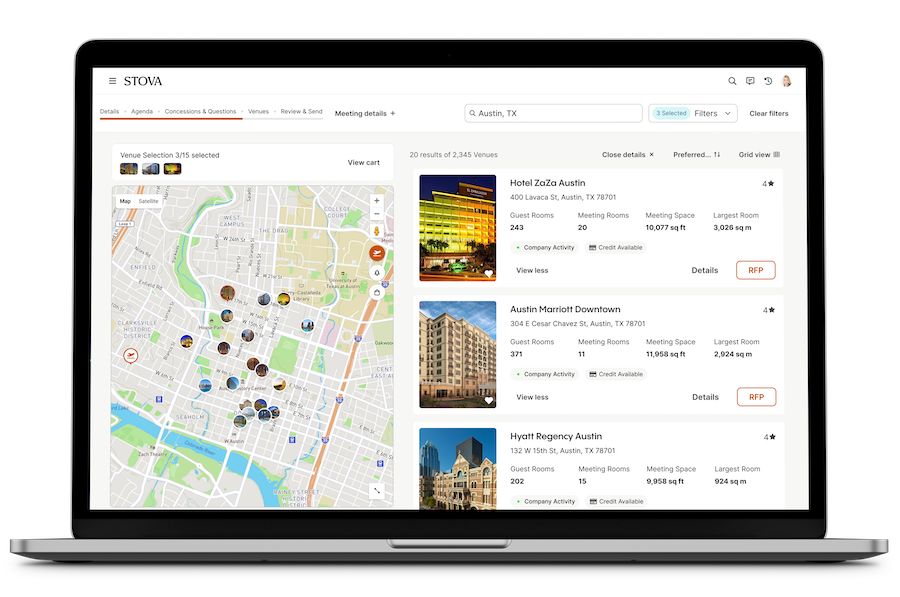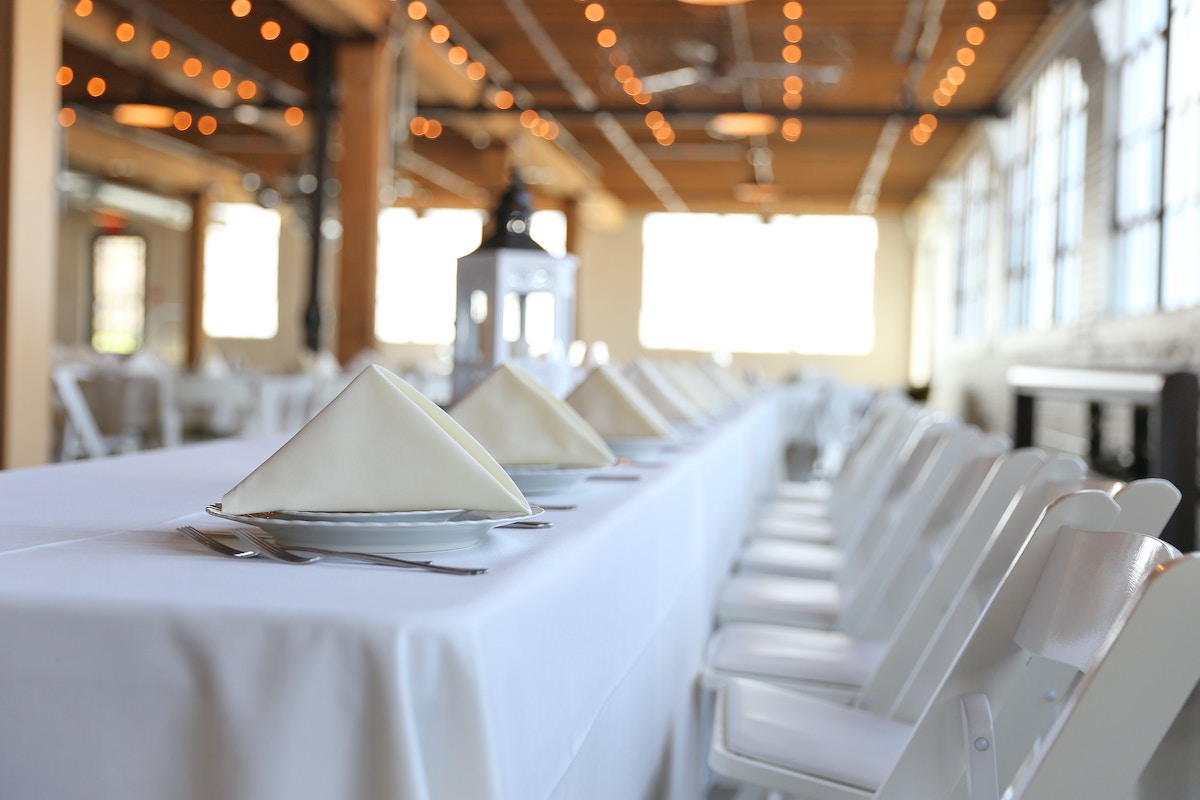Skift Take
Meeting planners are facing shorter lead times while also working to meet higher expectations on almost every front. Here are the strategies and tools that will help you source venues as efficiently as possible — without ever missing a beat.
This content was created collaboratively by Stova and Skift’s branded content studio, SkiftX.
The rapid return of in-person events has led to a surge in demand for venue spaces and record-breaking event attendance. Pressure is mounting to commit quickly at risk of losing opportunities; Skift Meetings’ 2022 State of Business Events report showed that over 75 percent of event planners were facing shorter lead times, and the situation has only become more intense since then. At the same time, the pandemic caused an unprecedented level of turnover in the hospitality industry. The contacts that event planners have developed over years may have moved on to new positions or even retired. If there were ever a time to venture beyond the tried and true event planning techniques of the past, it’s now.
But innovation can’t come at the cost of excellence; it’s as crucial as ever for event planners to get each and every logistical detail right. As we continue to put the pandemic in our rear-view mirror and gather in person more frequently, attendees’ expectations are higher than ever. Planners can’t afford to slip up when it comes to selecting a venue that delivers outstanding face-to-face experiences and hits all the right notes in terms of layout, accessibility, AV production, and safety. Is there a more efficient way to find the right fit in this pressure cooker?
With the right strategies and technological solutions, it’s possible to source venues smoothly and efficiently, without sacrificing any of the essential details that make in-person events so meaningful. Here are five steps to a more effective venue sourcing process.
1. Establish Key Priorities With Stakeholders
The first step in narrowing down a range of venue choices is to design your top criteria for both the event destination and the venue itself. Start by thinking through your travel priorities: Does the venue need to be located in the same city, state, or country as your main offices or the majority of your organization members? Flight time limitations for environmental, social, and governance (ESG) reporting purposes might influence planners to choose a venue close to home, while the appeal of a far-flung destination might be more appropriate for groups that are already distributed globally and expecting to travel.
Company-Wide Preferences
Referencing company travel policies will also help planners create a short-list of venue options. Has your organization negotiated a company-wide sales agreement for special rates with a particular hotel brand? Think also about the hospitality experience your stakeholders, employees, or guests are accustomed to expect from your events, and check each potential venue’s star rating to ensure that you’re providing an appropriate level of luxury or budget-friendliness.
Alignment on Values
Other big-picture factors to consider are the reputation of the destination and the venue. Does the city have a reputation as a safe and welcoming space for all of the attendees you hope to attract? It’s also wise to make sure that your business values are aligned with the venue brand as well, from sustainability to diversity, equity, and inclusion commitments. And no matter how exciting it may seem to travel to a new or exotic location, take seasonality into consideration to avoid inclement weather, or environmental roadblocks that might impact the success of your event.


2. Assess Options Against Key Criteria
With those high-level considerations nailed down, it’s time to get into the nuts and bolts of event planning logistics in your venue sourcing process. Make sure the venue you’ve selected has the capacity to handle your expected number of attendees, and the right rooms in the right configuration to accommodate your programming. From intimate meeting rooms to adaptable banquet halls, the right layout is an absolutely critical aspect of finding an appropriate event venue.
Amenities and Services
Your programming should also help inform your needs for audio and visual (AV) equipment and services. You may need to project sound from a keynote speech, mirror video feeds to ensure that everyone can see the stage, or engage your audience with a social media wall. Whatever you’re planning, these are all components that you’ll need to plan out in advance — from the hardware and software itself to the technicians required to set up, tear down, and operate that equipment.
Make sure that the venue you select has the amenities and facilities to support both the needs of your audience and the content and context of your event. If recreation is a high priority, make sure the venue you’ve selected has a fitness center and swimming pool on the property or access to off site excursions. If you’re focused on health and wellness, access to spa services or healthy dining options might be more appropriate. Or if many of your event attendees are going to be driving to the venue, check that there is adequate parking available.
Accessibility and Security
If you are aware of specific accommodations that your guests may need in advance, you can plan ahead with your chosen venue to ensure everything is prepared. As a general rule of thumb for venue sourcing, it’s always a good idea to familiarize yourself with a venue’s accessibility features from main entrances to key event spaces and even hotel rooms. There are a variety of helpful resources available online, such as this hotel accessibility checklist from the Association of University Centers on Disabilities. For more detailed information, look into resources published by the associations that represent specific disabilities. And hiring a disability access consultant is the gold standard for ensuring true inclusion.
Your event security needs may also vary greatly, depending on the location of the hotel or any VIPs you have invited to either attend or present. Make sure the venue’s security protocols are sufficient to address your concerns and check that there are options to scale up or scale down additional security staff and safety measures as necessary.
3. Using Tech to Identify Venues That Match Criteria
We’ve only looked at two steps so far, but you may already feel overwhelmed with all the considerations that come into play. That’s why step number three is to use technology tools to manage and match all the factors that go into successful event venue selection. With Stova’s venue sourcing software, for example, you can set your criteria at the beginning of your search and apply filters to see only the venues that meet your specific needs.


Stova’s user-friendly interface allows you to search over 250,000 unique event venues for the one that matches all of your priorities. Quickly assess key details, facts, and figures at a glance, including total meeting space, largest meeting space, parking availability, and more. If your company has a preferred hotel brand — or even a specific chain — you can filter for that, even setting the star rating you want.
You can also search using settings specific to your company’s profile, like venues your team has rated highly in the past or those where you have credits available. Then drill down even deeper by searching for the key criteria you identified in step two: capacity and layout, dining options, fitness amenities, facilities, guest services, AV equipment and services, accessibility, security, and many more. Just to demonstrate how granular you can be, it’s possible to filter specifically for free parking.
4. Streamline the RFP Process for Venue Sourcing
Ideally, the tech tools that empower your search should also function to create and send Requests for Proposals (RFPs) to the venues that make it on your short list. For example, once you’ve set your criteria in Stova and applied the filters that represent your most important selection priorities, you can quickly send multiple RFPs directly to the venues that come up in your search results. This doesn’t just cut down on manual effort; it also streamlines the RFP process so that the only venues you spend time engaging with at this stage are already pre-filtered to ensure they are actually potential matches for your event needs.
The Stova team is even available to coach event planners on optimizing the RFP itself, ensuring you receive the most high-quality responses possible complete with answers to all the considerations that are most important to you. Stova’s RFP process captures meeting details, agendas, concessions, and other key factors driving your decision making. The Stova team also works with the RFP respondents to ensure an efficient and effective use of the response formats for quick turnaround. The platform then presents the bid summary in a side by side comparison chart so it’s as easy as possible for planners to make their final decision.
5. Negotiate the Best Deal
The final step is securing an event contract with the venue, and one of the most effective ways to negotiate the best deal is by having clear insight into past business. Your tech-enabled venue search tools should make it easy to track all your past deals and contracts, and keep records of your communication with each venue in one place. That way you can use past events as business insights, demonstrating value to your prospective venue partners in terms of repeat business and the promise of future commitments. This ultimately allows you to leverage preferred partnerships or other mutually beneficial connections, in turn negotiating better and fairer deals.
Year-Over-Year Data on Venue Sourcing
In addition to tracking bids and company-wide business efforts (above and beyond the progress of your own immediate event planning), Stova tracks and presents year-over-year data in an intuitive business insights tool. Centralizing your past and ongoing communications with venues and travel or hospitality brands makes it easy to nurture relationships and build up strong professional networks, while standardized reports around cost per event, cost per venue, savings per event, and other KPIs ensure that you’re always negotiating the best deal possible.
This kind of holistic oversight helps event planners manage their budgets more effectively as well as providing key stakeholders with a clear picture of their total spend and overall savings on budget; there’s no better way to avoid costly last-minute surprises than careful advance planning.


The Time for Automation
The pace of professional events in our post-pandemic reality doesn’t leave room for painstaking consideration and manual effort anymore. It’s time for modern event planners to use high-tech venue sourcing tools to achieve multiple business goals at the same time, increasing their efficiency around budgeting, logistics, and the booking process in order to better serve event attendees and guests.
To learn more about tech solutions that can streamline your venue booking process, schedule a demo with Stova today.
This content was created collaboratively by Stova and Skift’s branded content studio, SkiftX.
Photo credit:






